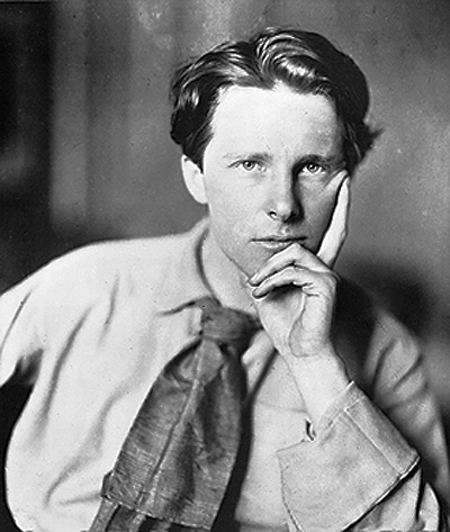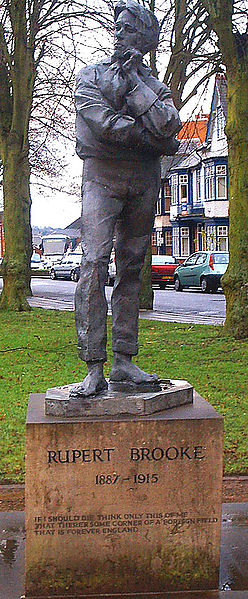<Back to Index>
- Scholar and Translator Étienne Dolet, 1509
- Poet Rupert Chawner Brooke, 1887
- 2nd Prime Minister of Australia Alfred Deakin, 1856
PAGE SPONSOR


Rupert Chawner Brooke (middle name sometimes given as Chaucer) (3 August 1887 – 23 April 1915) was an English poet known for his idealistic war sonnets written during the First World War (especially The Soldier). He was also known for his boyish good looks, which prompted the Irish poet William Butler Yeats to describe him as "the handsomest young man in England".
Brooke was born at 5 Hillmorton Road in Rugby, Warwickshire, the second of the three sons of William Parker Brooke, a Rugby schoolmaster, and Ruth Mary Brooke, née Cotterill. He was educated at two independent schools in the market town of Rugby, Warwickshire; Hillbrow School and Rugby School.
While travelling in Europe he prepared a thesis entitled "John Webster and the Elizabethan Drama", which won him a scholarship to King's College, Cambridge, where he became a member of the Cambridge Apostles, helped found the Marlowe Society drama club and acted in plays including the Cambridge Greek Play. Brooke made friends among the Bloomsbury group of writers, some of whom admired his talent while others were more impressed by his good looks. Virginia Woolf boasted to Vita Sackville-West of once going skinny dipping with Brooke in a moonlit pool when they were at Cambridge together. Brooke belonged to another literary group known as the Georgian Poets and was one of the most important of the Dymock poets, associated with the Gloucestershire village of Dymock where he spent some time before the war. He also lived in the Old Vicarage, Grantchester (a house now occupied by Cambridge chemist Mary Archer and her husband, the novelist Jeffrey Archer). Brooke
suffered from a severe emotional crisis in 1913, caused by sexual
confusion and jealousy, resulting in the breakdown of his long
relationship with Ka Cox (Katherine Laird Cox). Intrigue by both Virginia Woolf and Lytton Strachey is said to have played a part in Brooke's nervous collapse and subsequent rehabilitation trips to Germany. As part of his recuperation Brooke toured the United States and Canada to write travel diaries for the Westminster Gazette. He took the long way home, sailing across the Pacific and staying some months in the South Seas. Much later it was revealed that he may have fathered a daughter with a Tahitian woman named Taatamata with whom he seems to have enjoyed his most complete emotional relationship. Brooke
fell heavily in love several times with both men and women, although
his bisexuality was edited out of his life by his first literary executor. Many more people were in love with him. Brooke was romantically involved with the actress Cathleen Nesbitt and was once engaged to Noel Olivier, whom he met while she was a 15 year old at the progressive Bedales School. Brooke was an inspiration to poet John Gillespie Magee, Jr.,
author of the poem "High Flight". Magee idolised Brooke and wrote a
poem about him ("Sonnet to Rupert Brooke"). Magee also won the same
poetry prize at Rugby School that Brooke had won 34 years prior. Brooke's most famous collection of poetry, "1914 & Other Poems"
was first published in May 1915, and in testament to his popularity ran
through 11 further impressions that year, and by June 1918 had reached
its 24th impression; a process undoubtedly fuelled through posthumous interest. Brooke's accomplished poetry gained many enthusiasts and followers and he was taken up by Edward Marsh who brought him to the attention of Winston Churchill, then First Lord of the Admiralty. He was commissioned into the Royal Naval Volunteer Reserve as a temporary Sub-Lieutenant shortly after his 27th birthday and took part in the Royal Naval Division's Antwerp expedition in October 1914. He sailed with the British Mediterranean Expeditionary Force on 28 February 1915 but developed sepsis from an infected mosquito bite. He died at 4:46 pm on 23 April 1915 in a French hospital ship moored in a bay off the island of Skyros in the Aegean on his way to battle at Gallipoli. As the expeditionary force had orders to depart immediately, he was buried at 11 pm in an olive grove on Skyros, Greece. The site was chosen by his close friend, William Denis Browne, who wrote of Brooke's death: His grave remains there today. Another friend — and war poet — Patrick Shaw-Stewart, also played a prominent role in Brooke's funeral. On 11 November 1985, Brooke was among 16 First World War poets commemorated on a slate monument unveiled in Poets' Corner in Westminster Abbey. The inscription on the stone was written by a fellow war poet, Wilfred Owen. It reads: "My subject is War, and the pity of War. The Poetry is in the pity." Brooke's brother, 2nd Lt. William Alfred Cotterill Brooke, was a member of the 8th Battalion London Regiment (Post Office Rifles) and was killed in action near Le Rutoire Farm on 14 June 1915 aged 24. He is buried in Fosse 7 Military Cemetery (Quality Street), Mazingarbe, Pas de Calais, France. He had only joined the battalion on 25 May.